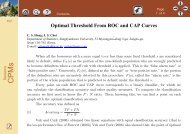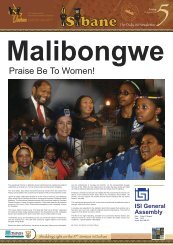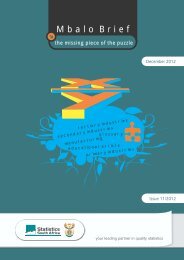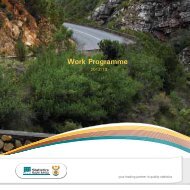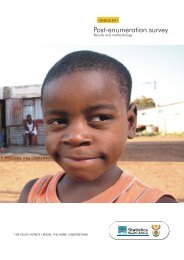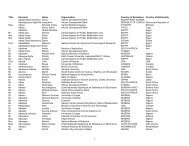General household survey - Statistics South Africa
General household survey - Statistics South Africa
General household survey - Statistics South Africa
Create successful ePaper yourself
Turn your PDF publications into a flip-book with our unique Google optimized e-Paper software.
<strong>Statistics</strong> <strong>South</strong> <strong>Africa</strong> 43<br />
P0318<br />
18. Technical notes<br />
18.1 Methodology and fieldwork<br />
A multi-stage design was used, which is based on a stratified design with probability proportional to size<br />
selection of primary sampling units (PSUs) at the first stage and sampling of dwelling units (DUs) with<br />
systematic sampling at the second stage. After allocating the sample to the provinces, the sample was<br />
further stratified by geography (primary stratification), and by population attributes using Census 2001 data<br />
(secondary stratification). Survey officers employed and trained by Stats SA visited all the sampled<br />
dwelling units in each of the nine provinces. During the first phase of the <strong>survey</strong>, sampled dwelling units<br />
were visited and informed about the coming <strong>survey</strong> as part of the publicity campaign. The actual interviews<br />
took place four weeks later. A total of 25 653 <strong>household</strong>s (including multiple <strong>household</strong>s) were successfully<br />
interviewed during face-to-face interviews.<br />
Two hundred and thirty-three enumerators (233) and 62 provincial and district coordinators participated in<br />
the <strong>survey</strong> across all nine provinces. An additional 27 quality assurors were responsible for monitoring and<br />
ensuring questionnaire quality. National training took place over a period of four days. The national trainers<br />
then trained provincial trainers for five days at provincial level. They in turn provided district training to the<br />
<strong>survey</strong> officers for a period of six days.<br />
18.2 The questionnaire<br />
Table 13 summarises the details of the questions included in the GHS questionnaire. The questions are<br />
covered in four sections, each focusing on a particular aspect. Depending on the need for additional<br />
information, the questionnaire is adapted on an annual basis. New sections may be introduced on a<br />
specific topic for which information is needed or additional questions may be added to existing sections.<br />
Likewise, questions that are no longer necessary may be removed.<br />
The GHS questionnaire has undergone some revisions over time. These changes were primarily the result<br />
of shifts in focus of government programmes over time. The 2002–2004 questionnaires were very similar.<br />
Changes made to the GHS 2005 questionnaire included additional questions in the education section with<br />
a total of 179 questions. Between 2006 and 2008, the questionnaire remained virtually unchanged. In<br />
preparation for GHS 2009. Extensive stakeholder consultation took place during which the questionnaire<br />
was reviewed to be more in line with the monitoring and evaluation frameworks of the various government<br />
departments. Particular sections that were modified substantially during the review were the sections on<br />
education, social development, housing, agriculture, and food security.<br />
Even though the number of sections and pages in the questionnaire remained the same, questions in the<br />
GHS 2009 were increased from 166 to 185 between 2006 and 2008. Following the introduction of a<br />
dedicated <strong>survey</strong> on Domestic Tourism, the section on tourism was dropped for GHS 2010. Due to a<br />
further rotation of questions, the GHS 2011 questionnaire contained 166 questions.<br />
Table 13: Contents of the GHS 2011 questionnaire<br />
Number of<br />
Section questions Details of each section<br />
Household information, response details, field staff information, result<br />
Cover page<br />
codes, etc.<br />
Flap 6 Demographic information (name, sex, age, population group, etc.)<br />
Section 1 55 Biographical information (education, health, disability, welfare)<br />
Section 2 20 Economic activities<br />
Household information (type of dwelling, ownership of dwelling, electricity,<br />
Section 3 65 water and sanitation, environmental issues, services, transport, etc.)<br />
Food security, income and expenditure (food supply, agriculture,<br />
Section 4 20 expenditure, etc.)<br />
All sections 166 Comprehensive coverage of living conditions and service delivery<br />
<strong>General</strong> Household Survey, July 2011



